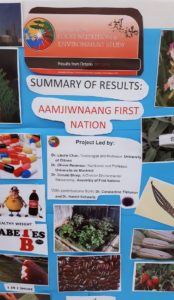New study finds First Nations in Canada face serious problems with food supply

By Colin Graf
AAMJIWNAANG FIRST NATION— First Nations across Canada face serious problems with food supply, such as poor nutrition, lack of food security, and food costs, according to a new government study, the largest of its kind ever conducted.
The First Nations Food, Nutrition & Environment Study (FNFNES), launched over eight years ago, is needed because First Nations people living on their territory have been excluded from other national studies about the diet, traditional food and environmental contaminants to which First Nations are exposed, the study’s summary reads.
Almost half (48 per cent) of people surveyed from First Nations across Canada during 2011-12, suffered from food insecurity (the ability of households to access enough food), a rate more than three times that of Canadians in general, according to the FNFNES. In Ontario, more families were secure in their food access, but almost a third (29 per cent) still reported food insecurity, fearing food would run out before they could buy more, the study has found.
The diet of First Nations adults in Ontario does not meet nutrition needs, but their diet is healthier when traditional foods are eaten, according to the study’s Ontario summary. The most common traditional foods in Ontario include walleye/pickerel, moose, whitefish, Canada goose, and blueberries.
Traditional foods are generally safe to eat in Ontario, but the study recommends hunters use steel shot rather than lead, as elevated lead concentrations, likely from shot, were found in some game meat. Lead can be harmful to the brain, especially in children. Other recommendations include limiting consumption of moose liver and kidney, and encouraging women of childbearing age, teenagers, and children to choose smaller size walleye, pike, and lake trout, due to possible mercury contamination.
In Ontario, 1,429 adults from 18 First Nations took part in surveys during 2011 and 2012. Six of those surveyed First Nations were Anishinabek member First Nations, including Aamjiwnaang and Munsee Delaware in southwestern Ontario, along with Garden River, Atikameksheng, Sagamok, and Fort William further north.
The study says First Nation adults in Ontario do not meet the minimum number of recommended servings in three food groups; vegetables and fruit, grain products, and milk and alternatives, according to Canada’s Food Guide for First Nations, Inuit, and Métis. The high intake of meat might contribute to a higher fat intake.
On days traditional food was eaten, the intake of almost all nutrients was significantly higher while the intake of saturated fat was lower when all 92 First Nations surveyed across Canada were considered.
Other health issues besides food access and nutrition were found in the NFNES.
“The health of many First Nation adults is compromised with very high rates” of smoking, obesity and diabetes, according to the Canada-wide summary. In Ontario, 50 per cent of adults surveyed were classed as obese, another 35 per cent overweight, 26 per cent had diabetes, and almost half (49 per cent) described themselves as smokers.
In Aamjiwnaang, a community located next to the southern Ontario city of Sarnia, much less traditional food was eaten than the provincial average— only two teaspoonful’s a day, with the most common types being pickerel, corn, kidney beans, deer, and bass. Even near an urban area with readily-available grocery stores, 24 per cent of Aamjiwnaang households in the study were described as food insecure.
In all regions of Canada, food costs were higher for communities outside of major urban centres.
“A healthy food basket remains far out of reach for many communities,” with food costs often two to three times higher in places more than 50 kilometers away from an urban centre, claim the principal investigators of the study. Costs were even higher in fly-in communities.
The investigators say that over half of adults studied told them supplies of traditional food are “impacted by industry-related activities, as well as climate change.“ The researchers recommend governments recognize “Indigenous priorities and values” when making decisions about land use, conservation, habitat protection, and access to traditional food.
The authors also want governments to help with nutrition gaps and food security by providing subsidies for initiatives like local gardens, greenhouses, hydroponic units, or other agricultural activities on First Nations. They say food price differences between urban centres and First Nations can be reduced if politicians increase access to subsidy programs such as Nutrition North and provide financial support to First Nation-operated food production and distribution organizations.
The study also looked at water quality and chemical pollution, finding that water quality is overall satisfactory, but close monitoring is warranted as water sources and water treatment vary greatly. Mercury exposure, as measured in hair samples and calculated through dietary estimates, is not a serious health concern, and neither is chemical contamination of traditional food.


